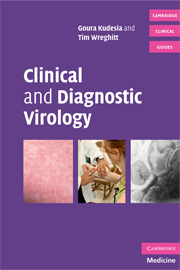Book contents
- Frontmatter
- Contents
- List of plates
- Preface
- Acknowledgements
- SECTION 1 INDIVIDUAL VIRUSES
- SECTION 2 OTHER RELATED AGENTS
- SECTION 3 CLINICAL SYNDROMES
- SECTION 4 DIAGNOSTIC TECHNIQUES
- SECTION 5 PATIENT MANAGEMENT
- 50 Antiviral drugs
- 51 Viral vaccines
- 52 Infection control
- 53 Occupational health
- Index
- Plate section
52 - Infection control
Published online by Cambridge University Press: 07 December 2009
- Frontmatter
- Contents
- List of plates
- Preface
- Acknowledgements
- SECTION 1 INDIVIDUAL VIRUSES
- SECTION 2 OTHER RELATED AGENTS
- SECTION 3 CLINICAL SYNDROMES
- SECTION 4 DIAGNOSTIC TECHNIQUES
- SECTION 5 PATIENT MANAGEMENT
- 50 Antiviral drugs
- 51 Viral vaccines
- 52 Infection control
- 53 Occupational health
- Index
- Plate section
Summary
Infection control is a significant part of a clinical virologist's work. It is an important public health tool in the preventative measures to stop the spread of viral infections. To do this we must first understand how viruses spread and gain entry to infect susceptible hosts. Viruses may gain entry through mucous membranes or directly through blood. Skin, although a good barrier to infection, may also allow viral entry especially in the presence of breaks in the skin surface. Infections may then be localized to the site of entry or spread via the blood stream (viraemia) to distant sites and cause systemic infection. The route by which viruses enter the host to establish infection is dictated very much by viral cell tropism.
Viruses and their route of entry and spread
Respiratory route
There are a large number of viruses besides the respiratory viruses that enter the host via the respiratory route. Primary infection is established in the respiratory tract epithelium, and virus is also shed from the respiratory tract. Infection may remain localized to the respiratory tract or spread to other sites through viraemia and cause systemic infection (e.g. chickenpox, smallpox, measles, mumps, rubella and parvovirus B19 infections).
The infection is spread via small droplets, which are released in the environment while sneezing, coughing etc. These droplets containing the infectious virus may either be inhaled or be inoculated into respiratory mucous membrane via contaminated hands or fomites such as handkerchiefs.
- Type
- Chapter
- Information
- Clinical and Diagnostic Virology , pp. 239 - 245Publisher: Cambridge University PressPrint publication year: 2009

